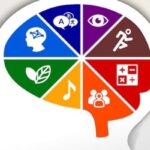We explain what linguistic intelligence is, what its characteristics are and how to develop it. Also, examples and other types of intelligence.

What is linguistic intelligence?
Linguistic intelligence or linguistic-verbal intelligence It is the ability to capture, organize, understand and use verbal language orally or in writing. It involves the use of words, phrases, and sentences to communicate a message.
It is one of the types of intelligence established by the American psychologist Howard Gardner (1943) in his theory of multiple intelligences of 1983, in which he proposed seven types of intelligence: linguistic, musical, logical-mathematical, kinesthetic-bodily, spatial, interpersonal and intrapersonal.
linguistic intelligence includes the management of writing, oral expression and poetic resources. People with high linguistic intelligence have a particular facility for learning languages, using words and organizing language.
Adequate management of linguistic intelligence allows the approach to other intelligences which in many aspects require language to develop. In this sense, it is an intelligence of an instrumental nature. For example, verbal language allows the formulation and understanding of logical-mathematical approaches.
Key points
- Linguistic intelligence is the ability to use oral or written language effectively, and to reflect on its use.
- People with linguistic intelligence usually have ease of communication, the ability to understand the structure of language, and an interest in words.
- Some of the professions related to this type of intelligence are those linked to writing, journalism, storytelling, communication and advocacy.
- To develop linguistic intelligence, it is recommended to read and practice writing, learn new languages, participate in debates and play games that involve words.
Characteristics of people with linguistic intelligence
Linguistic intelligence is a fundamental aptitude of human beings, which begins its development from the first years of life. Gardner distinguished four basic aspects of linguistic knowledge: the rhetorical (used to persuade), the mnemonic (used to remember information), the explanatory (used to transmit information) and the metalinguistic (used to reflect on one's own language).
Therefore, people who have high linguistic intelligence are characterized by their ability to:
- Argue and present ideas in an attractive way.
- Use language to remember information, for example, through rhymes.
- Explain complex concepts or ideas clearly.
- Understand the rules of language and its uses in different contexts.
- Understand and analyze written texts.
- Learn languages with ease.
- Capture people's attention by telling a story.
- Listen to and understand the ideas and thoughts expressed through language.
Examples of linguistic intelligence

People with linguistic intelligence can handle language effectively. For example, they express their ideas clearly, often enjoy reading and writing, use words to resolve conflicts, and can use language with humor and wit.
linguistic intelligence It is usually related to professions that require skills oratory persuasion or speaking ability,as lawyers, politicians, teachers, journalists, translators, writers, poets and songwriters.
Some historical figures recognized for their high linguistic intelligence are William Shakespeare, Virginia Wolf, Noam Chomsky, Dante Alighieri, John Bowring and Jane Austen.
Activities to develop linguistic intelligence
To develop linguistic intelligence, it is necessary stimulate language-related skills: speaking, listening, reading and writing.
Some simple activities that enhance this type of intelligence are:
- Learn new languages Knowing other languages helps improve understanding of language in general.
- Read. Adopt the habit of reading different literary genres, such as poetry, novels or essays.
- Learn about literature. Participate in reading workshops, literary expression courses or similar.
- Practice word games Performing exercises and games, such as crossword puzzles, riddles, word searches or tongue twisters, enhances linguistic thinking.
- Tell stories. Performing narration exercises improves the ability to structure language.
- Write. Practice written expression through creative writing of stories, stories or poems. Also, exercise writing by writing for communicative purposes, such as notes or letters.
- Participate in debates. Arguing and defending a point of view improves oral skills.
Other types of intelligence
The other types of intelligence that are part of Howard Gardner's theory of multiple intelligences are:
- musical intelligence It is the ability to perceive, appreciate and express rhythmic patterns and musical forms.
- Logical-mathematical intelligence. It is the ability to use numbers to solve problems and think logically.
- Kinesthetic-body intelligence. It is the ability to handle tools related to body movement and touch.
- Spatial intelligence . It is the ability to perceive and understand spaces, such as the perception of the size of objects and proportions.
- Interpersonal intelligence . It is the ability to understand and relate to other people, through communication and empathy.
- intrapersonal intelligence . It is the ability to know oneself and understand one's own emotions and motivations.
document.addEventListener(“DOMContentLoaded”, (e) => { var sliderContainer, slider; sliderContainer = document.getElementById(‘block_bfff98985e24e3b88c56ad53401c0551’); if (typeof initSlider !== ‘function’) { console.log(‘Swiper haven\’t been loaded’); sliderContainer.className += ‘ fw scroll-snap’; return; }; options = { direction: ‘horizontal’, speed: 1000, slidesPerView: ‘auto’, // slidesPerGroup: 1, centerInsufficientSlides: true, // centeredSlides:true, spaceBetween: 15, breakpoints: { 720: { // centeredSlides: false, // slidesPerGroup: 2, spaceBetween: 25 }, }, pagination: { el: ‘.swiper-pagination’, type: ‘bullets’, clickable: true }, } slider = initSlider(sliderContainer, options); })
References
- Gardner, H. (1994). Structures of the mind. The theory of multiple intelligences. Economic Culture Fund.
- Grisales Grisales, MC (2008). Expression of linguistic intelligence in preschool children. Educational Pen5(1), 33-41. https://revistasum.umanizales.edu.co
- Pacheco Ruiz, M. (2014). Linguistic intelligence: The dress of thoughts. Education and Future, (31), 43-67. https://cesdonbosco.com





